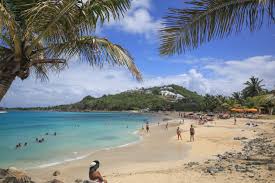General information about St. Maarten
Sint Maarten is an island located in the Caribbean. The island is divided between France and the Nederland, which is why people refer to the French or the Dutch side. Its population is approximately 75,000 people, spread all over the 87km2 of the island. St. Maarten may seem quite small when compared to Caribbean islands like Martinique, but still, its landscapes are tropical gems. The capital of the island is Philipsburg. If traveling to St. Maarten, you will experience the visit of two island colonies, and therefore, the spicy marriage of Caribbean, French and Dutch cultures in one small territory. Also, you will have the opportunity to enjoy some of the most beautiful beaches and landscapes of the Caribbean.
About St. Maarten – The island’s history
Christopher Columbus, according to the legend, anchored at the island on November 11, 1493. When he discovered the island, it was inhabited by Carib amerindians, who chased the Arawaks, an agricultural people living there before. Hence, the Caribs’ territory was not completely conquered in the mid-17th century, when the French, English, Dutch, Danes and Spanish started to fight for the control of the West Indies.
In the 1620’s, the Dutch were the first europeans to ply the island’s ponds for salt. But very soon, in 1633, the Spaniards recaptured St. Martin / St. Maarten. Thus, the Dutch built Fort Amsterdam and an artillery battery at Pointe Blanche. In 1648, France and the Dutch Republic signed the Treaty of Concordia. With this treaty, they agreed to divide the island between their two territories.
The border’s history
The history of this border is surrounded by folklore. According to local narratives, « to divide the island into two sections, the inhabitants were told to choose two walkers, one chosen by the French-dominated community and the other one by the Dutch-dominated community, who were put back to back in one extreme of the island, making them walk in opposite directions while stuck to the littoral line, and not allowing them to run. The point where they eventually met was set as the other extreme of the island, creating the border. Seemingly, the French walker had walked more than his Dutch adversary (54km2 and 32km2) ».
Starting in the 18th century, a massive influx of African slaves arrived, in order to fulfill the needs of sugarcane plantations, on both sides of the island. Hence, slavery is a very important element of the island’s history, as it took place until the first half of the 19th century. This complicated history had influence on the population, which is a combination of Amerindian, European, African, Indian and Asian peoples. St. Maarten’s economy heavily suffered after the abolition of slavery until its declaration as a duty-free port. After World Ward II, the Dutch side focused on tourism, and the French side followed the lead two decades later. Between this period and the 1990’s, the island’s demographics changed dramatically, increasing from a mere 5,000 people to around 60,000 people in the 1990’s.
About St. Maarten – The island’s culture
Although English is the most commonly spoken language with a local dialect, official languages are French for Saint-Martin and both Dutch and English for Sint Maarten. Some other dialects include French-based Créole and Spanish. The island is also the home of numerous leading artists, like the Youth Waves, Roland Richardson, Ruby Bute, Nicole de Weever, Lasana Sekou or Clara Reyes, all performing in different art fields.
The cuisine, as well as the parades or cultural events, are the witness of an eventful history. All of them are a mix between different cultures, resulting in an unique experience for travelers.



